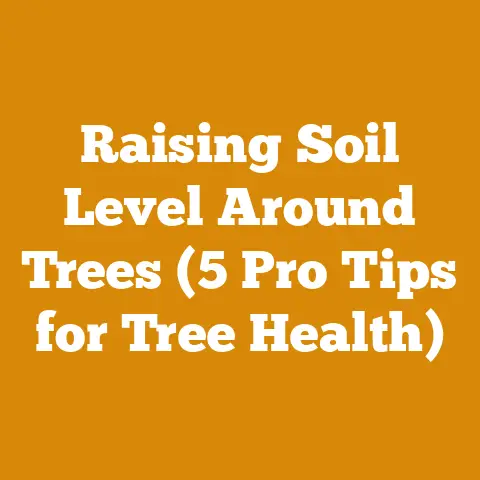Where to Plant Moringa Tree for Wood Use (Arborist Tips Inside)
You can’t just stick a moringa tree anywhere and expect it to become a timber source! Understanding where to plant your moringa for optimal wood production is paramount. As an arborist and someone who’s spent years wrestling with logs, chainsaws, and the unpredictable nature of wood, I’m here to give you the inside scoop. This isn’t just about throwing a seed in the ground; it’s about maximizing the tree’s potential to become a valuable resource.
Moringa for Wood: Location, Location, Location
Choosing the right location is the first, and arguably most crucial, step in growing moringa for wood. Think of it as setting the stage for a long and productive performance. Forget the old adage “any old place will do”; moringa, like any timber crop, has specific needs.
Understanding Moringa’s Environmental Needs
Moringa oleifera, often hailed as the “miracle tree,” is surprisingly adaptable, but it thrives in specific conditions. I’ve seen firsthand how neglecting these basic needs can lead to stunted growth and poor wood quality.
- Climate: Moringa flourishes in warm climates with temperatures consistently above 65°F (18°C). It’s frost-sensitive, so if you live in an area prone to freezing, you’ll need to take extra precautions, perhaps even considering indoor cultivation during the colder months. I learned this the hard way when a late frost decimated a young moringa plantation I was advising on in the foothills of the Himalayas. We had to replant and implement a frost protection system.
- Sunlight: Moringa needs at least 6-8 hours of direct sunlight per day. This is non-negotiable. Sunlight fuels photosynthesis, which drives growth and wood density. A shady spot will result in a spindly, weak tree. My experience in equatorial regions confirmed this; the moringa trees in full sun were significantly more robust than those partially shaded by other vegetation.
- Soil: Moringa is remarkably tolerant of poor soil, but it prefers well-drained sandy loam. Heavy clay soils can lead to root rot, a common problem I’ve encountered in poorly planned moringa plantations. I always recommend amending heavy clay soils with sand and organic matter to improve drainage. A simple percolation test can tell you a lot about your soil’s drainage capacity. Dig a hole, fill it with water, and see how quickly it drains. If it takes more than a few hours, you’ve got a drainage issue.
- Water: Moringa is drought-tolerant once established, but young trees need regular watering. However, avoid overwatering, which can lead to root rot. I’ve found that the “soak and dry” method works best – water deeply when the soil is dry to the touch, then allow it to dry out before watering again. This encourages deep root growth, making the tree more resilient.
Site Selection Considerations
Beyond the basic environmental needs, there are several other factors to consider when choosing a site for your moringa plantation.
- Space: Moringa trees can grow quite large, reaching heights of up to 40 feet (12 meters) and spreading up to 20 feet (6 meters) wide. Ensure you have enough space to accommodate the mature size of the trees. I recommend spacing trees at least 10-15 feet (3-4.5 meters) apart to allow for adequate sunlight penetration and airflow. This spacing also makes harvesting and maintenance easier.
- Accessibility: Consider how easily you can access the site for planting, maintenance, and harvesting. A remote location may seem appealing, but it can quickly become a logistical nightmare. I once worked on a project where the plantation was only accessible by a rough dirt road, making it incredibly difficult to transport seedlings, fertilizer, and harvesting equipment. The added transportation costs significantly reduced the profitability of the project.
- Proximity to Infrastructure: Access to water, electricity, and transportation infrastructure can be crucial, especially for larger-scale operations. Consider the cost of transporting water to the site, especially during dry periods. Electricity may be needed for irrigation pumps or processing equipment. And, of course, you’ll need to be able to transport the harvested wood to market.
- Soil Testing: Before planting, it’s a good idea to have your soil tested to determine its nutrient content and pH level. This will allow you to amend the soil as needed to ensure optimal growth. I recommend testing for nitrogen, phosphorus, potassium, and micronutrients like iron, zinc, and manganese. A pH level between 6.0 and 7.0 is ideal for moringa.
- Wind Protection: Moringa trees can be susceptible to wind damage, especially when young. Consider planting windbreaks to protect your trees from strong winds. I’ve seen entire plantations flattened by strong gusts, so this is not something to be taken lightly. Windbreaks can be as simple as a row of taller trees or shrubs planted along the windward side of the plantation.
Specific Location Types: Pros and Cons
Let’s break down some specific location types and their suitability for moringa wood production.
- Agricultural Land:
- Pros: Often has good soil, access to water, and existing infrastructure.
- Cons: May be expensive, and you may have to compete with other crops. I’ve also seen issues with soil compaction from heavy machinery, which can hinder root growth.
- Marginal Land:
- Pros: Less expensive, and moringa can help improve soil quality.
- Cons: May have poor soil, limited access to water, and require significant initial investment. I’ve had success using moringa to rehabilitate degraded land, but it requires patience and a long-term commitment.
- Homesteads/Backyards:
- Pros: Easy access, potential for small-scale production, and can provide shade and other benefits.
- Cons: Limited space, may not be suitable for large-scale production, and can compete with other uses. I’ve seen many homeowners successfully grow moringa for personal use, but it’s rarely a viable option for commercial wood production.
- Abandoned Land:
- Pros: Potentially inexpensive, opportunity to revitalize unused land.
- Cons: Soil may be depleted or contaminated, access may be difficult, and may require extensive site preparation. I’ve worked on several projects where we’ve reclaimed abandoned industrial sites using moringa, but it’s a complex and costly undertaking.
Preparing the Site for Planting
Once you’ve chosen the right location, the next step is to prepare the site for planting. This is where the real work begins. Don’t skimp on this step; proper site preparation can significantly impact the success of your plantation.
Clearing Vegetation
The first step is to clear the site of any existing vegetation. This includes trees, shrubs, weeds, and grasses. I prefer to use a combination of mechanical and manual methods, depending on the size of the site and the type of vegetation.
- Mechanical Clearing: For larger sites, a bulldozer or excavator can be used to clear the vegetation. However, be careful not to remove too much topsoil, as this can damage the soil structure and reduce its fertility. I always recommend leaving a thin layer of topsoil intact.
- Manual Clearing: For smaller sites, or in areas where mechanical clearing is not feasible, manual clearing can be used. This involves using hand tools like machetes, axes, and saws to remove the vegetation. It’s more labor-intensive, but it allows for more precise clearing and minimizes soil disturbance.
- Herbicide Application: In some cases, herbicides may be used to control weeds and grasses. However, I prefer to avoid using herbicides whenever possible, as they can have negative impacts on the environment and human health. If you do use herbicides, be sure to follow the manufacturer’s instructions carefully and use them sparingly.
Soil Preparation
After clearing the vegetation, the next step is to prepare the soil. This involves tilling or plowing the soil to loosen it and improve drainage.
- Tilling/Plowing: Tilling or plowing the soil helps to break up compacted soil, improve aeration, and incorporate organic matter. I recommend tilling to a depth of at least 12 inches (30 cm). Be careful not to till too deeply, as this can bring up subsoil that is low in nutrients.
- Soil Amendment: After tilling, amend the soil with organic matter, such as compost, manure, or green manure. This will improve the soil’s fertility, water-holding capacity, and drainage. I recommend adding at least 2-3 inches (5-7.5 cm) of organic matter to the soil.
- Fertilization: Depending on the results of your soil test, you may need to add fertilizer to the soil. I recommend using a balanced fertilizer that contains nitrogen, phosphorus, and potassium. Apply the fertilizer according to the manufacturer’s instructions.
- pH Adjustment: If your soil is too acidic or alkaline, you may need to adjust the pH level. To raise the pH, add lime to the soil. To lower the pH, add sulfur or organic matter. Aim for a pH level between 6.0 and 7.0.
Creating Planting Holes
Once the soil is prepared, the next step is to create planting holes. The size of the planting holes will depend on the size of the seedlings you are planting.
- Hole Size: I recommend digging planting holes that are at least twice as wide and twice as deep as the root ball of the seedlings. This will give the roots plenty of room to grow.
- Spacing: Space the planting holes according to the recommended spacing for moringa trees, which is typically 10-15 feet (3-4.5 meters) apart.
- Drainage: If your soil is poorly drained, you may need to improve drainage in the planting holes. This can be done by adding gravel or sand to the bottom of the holes.
Planting Moringa Trees
With the site prepared, it’s time to plant your moringa trees. This is a critical step that can determine the success of your plantation.
Selecting Seedlings
The quality of the seedlings you plant will have a significant impact on the growth and productivity of your plantation. Choose healthy, vigorous seedlings from a reputable nursery.
- Seedling Size: I recommend planting seedlings that are at least 12 inches (30 cm) tall. Avoid planting seedlings that are too small or too large, as they may not transplant well.
- Root System: Choose seedlings with a well-developed root system. Avoid seedlings with root-bound or circling roots.
- Stem and Leaves: Choose seedlings with a straight, sturdy stem and healthy green leaves. Avoid seedlings with damaged or diseased stems or leaves.
- Source: Purchase seedlings from a reputable nursery that specializes in moringa. Ask about the source of the seeds and the growing conditions of the seedlings.
Planting Techniques
The planting technique you use can also impact the success of your plantation. Follow these tips for planting moringa trees:
- Timing: Plant moringa trees during the rainy season, when the soil is moist and the weather is cool. This will give the seedlings the best chance of survival.
- Handling: Handle the seedlings carefully to avoid damaging the roots. Gently remove the seedlings from their containers and loosen the root ball.
- Placement: Place the seedlings in the planting holes, making sure that the top of the root ball is level with the surrounding soil.
- Backfilling: Backfill the planting holes with soil, gently firming the soil around the roots.
- Watering: Water the seedlings thoroughly after planting.
- Mulching: Mulch around the base of the seedlings with organic matter, such as straw, wood chips, or leaves. This will help to retain moisture in the soil and suppress weeds.
Post-Planting Care
After planting, it’s important to provide ongoing care to ensure the survival and growth of your moringa trees.
- Watering: Water the seedlings regularly, especially during dry periods. I recommend watering deeply once or twice a week, rather than watering lightly every day.
- Weeding: Keep the area around the seedlings free of weeds. Weeds can compete with the seedlings for water and nutrients.
- Fertilizing: Fertilize the seedlings every few months with a balanced fertilizer. Follow the manufacturer’s instructions.
- Pruning: Prune the seedlings to encourage branching and a strong central leader. I recommend pruning off any dead or damaged branches.
- Pest and Disease Control: Monitor the seedlings for pests and diseases. If you notice any problems, take action to control them. I prefer to use organic pest and disease control methods whenever possible.
- Protection: Protect the seedlings from animals, such as rabbits and deer. This can be done by fencing the area or using tree guards.
Moringa Wood Properties and Uses
Now, let’s talk about the wood itself. Moringa wood is a relatively soft wood, but it has some unique properties that make it suitable for certain applications. Knowing these properties will help you determine the best uses for your moringa wood.
Wood Characteristics
- Density: Moringa wood has a low density, typically around 0.4 g/cm3. This makes it lightweight and easy to work with.
- Strength: Moringa wood is not very strong, with a modulus of rupture (MOR) of around 4,000 psi and a modulus of elasticity (MOE) of around 400,000 psi. This means it’s not suitable for structural applications where high strength is required.
- Durability: Moringa wood is not very durable and is susceptible to decay and insect attack. It needs to be treated with preservatives if it’s going to be used outdoors.
- Grain: Moringa wood has a straight grain and a fine texture. It’s easy to saw, plane, and sand.
- Color: Moringa wood is typically light-colored, ranging from white to pale yellow.
Suitable Uses
Given its properties, moringa wood is best suited for the following applications:
- Firewood: Moringa wood burns easily and produces a good amount of heat. However, it burns quickly, so it’s not ideal for long-lasting fires. I’ve found that mixing it with denser hardwoods can improve its burning properties.
- Pulpwood: Moringa wood can be used to make pulp for paper production. Its low density and high cellulose content make it a good choice for this application.
- Craftwood: Moringa wood is easy to work with and can be used to make small crafts, such as carvings, toys, and utensils.
- Light Construction: Moringa wood can be used for light construction applications, such as fences, sheds, and furniture. However, it needs to be treated with preservatives to prevent decay and insect attack.
- Biofuel: Moringa wood can be used to produce biofuel, such as ethanol or biodiesel. This is a promising application that could help to reduce our reliance on fossil fuels.
Unsuitable Uses
Moringa wood is not suitable for the following applications:
- Structural Applications: Moringa wood is not strong enough to be used for structural applications, such as beams, joists, and rafters.
- Heavy Construction: Moringa wood is not durable enough to be used for heavy construction applications, such as bridges and buildings.
- Flooring: Moringa wood is too soft to be used for flooring, as it would quickly wear out.
- Outdoor Furniture: Moringa wood is not durable enough to be used for outdoor furniture unless it’s treated with preservatives.
Harvesting and Processing Moringa Wood
Once your moringa trees have reached maturity, it’s time to harvest and process the wood. This is a critical step that can impact the quality and value of the wood.
Harvesting Techniques
The harvesting technique you use will depend on the size of the trees and the type of wood you want to produce.
- Manual Harvesting: For small-scale operations, manual harvesting can be used. This involves using hand tools, such as axes, saws, and machetes, to fell the trees. It’s more labor-intensive, but it allows for more precise harvesting and minimizes damage to the surrounding environment. I’ve found that a sharp axe and a good bow saw are essential tools for manual harvesting.
- Mechanical Harvesting: For larger-scale operations, mechanical harvesting can be used. This involves using heavy machinery, such as chainsaws, feller bunchers, and skidders, to fell and extract the trees. It’s faster and more efficient, but it can also be more damaging to the environment. When using chainsaws, always wear appropriate safety gear, including a helmet, eye protection, hearing protection, and chaps.
Processing Techniques
After harvesting, the wood needs to be processed to make it suitable for its intended use.
- Sawing: The first step in processing moringa wood is to saw it into boards or planks. This can be done using a chainsaw, a portable sawmill, or a stationary sawmill. I prefer using a portable sawmill, as it allows me to process the wood on-site, which reduces transportation costs.
- Drying: After sawing, the wood needs to be dried to reduce its moisture content. This can be done by air-drying or kiln-drying. Air-drying is a slower process, but it’s less expensive and produces higher-quality wood. Kiln-drying is faster, but it can be more expensive and can damage the wood if it’s not done properly. I recommend air-drying moringa wood for at least 6 months to reduce its moisture content to around 12%.
- Planing: After drying, the wood can be planed to create a smooth, even surface. This can be done using a hand plane or a power planer.
- Sanding: After planing, the wood can be sanded to create an even smoother surface. This can be done using sandpaper or a power sander.
- Finishing: After sanding, the wood can be finished with a sealant, stain, or varnish. This will protect the wood from moisture and insects and enhance its appearance. I recommend using a water-based finish, as it’s more environmentally friendly than solvent-based finishes.
Challenges and Considerations
Growing moringa for wood isn’t without its challenges. Understanding these potential pitfalls can help you avoid costly mistakes.
Pests and Diseases
Moringa trees can be susceptible to a variety of pests and diseases, including:
- Termites: Termites can attack the roots and stems of moringa trees, causing them to weaken and die. I recommend treating the soil with a termiticide before planting to prevent termite infestations.
- Powdery Mildew: Powdery mildew is a fungal disease that can affect the leaves of moringa trees. It causes a white, powdery coating on the leaves, which can reduce photosynthesis and stunt growth. I recommend spraying the trees with a fungicide to control powdery mildew.
- Root Rot: Root rot is a fungal disease that can affect the roots of moringa trees. It’s caused by poorly drained soil and overwatering. I recommend improving drainage and avoiding overwatering to prevent root rot.
- Caterpillars: Caterpillars can feed on the leaves of moringa trees, causing defoliation. I recommend hand-picking the caterpillars or spraying the trees with an insecticide to control caterpillar infestations.
Environmental Factors
Environmental factors can also impact the growth and productivity of moringa trees.
- Drought: Moringa trees are drought-tolerant, but they can still be affected by prolonged periods of drought. I recommend irrigating the trees during dry periods to ensure adequate growth.
- Frost: Moringa trees are frost-sensitive and can be damaged by freezing temperatures. I recommend protecting the trees from frost by covering them with blankets or plastic sheeting.
- Wind: Moringa trees can be damaged by strong winds. I recommend planting windbreaks to protect the trees from wind damage.
- Soil Erosion: Soil erosion can be a problem in areas with steep slopes or poor soil. I recommend implementing soil conservation measures, such as terracing and contour planting, to prevent soil erosion.
Market Demand
The market demand for moringa wood is still relatively small. Before investing in a large-scale moringa plantation, it’s important to assess the market demand in your area.
- Local Markets: Identify local markets for moringa wood, such as firewood dealers, pulpwood mills, and craft shops.
- Export Markets: Explore export markets for moringa wood, such as paper mills and biofuel producers.
- Value-Added Products: Consider producing value-added products from moringa wood, such as furniture, crafts, and biofuel.
Sustainability
It’s important to manage your moringa plantation sustainably to ensure its long-term productivity.
- Reforestation: Reforest harvested areas with new moringa trees to maintain a continuous supply of wood.
- Soil Conservation: Implement soil conservation measures to prevent soil erosion and maintain soil fertility.
- Water Management: Manage water resources efficiently to ensure adequate water availability for moringa trees.
- Pest and Disease Management: Use integrated pest and disease management practices to minimize the use of pesticides and fungicides.
My Personal Moringa Wood Project: A Case Study
Let me share a story from a project I spearheaded in rural Kenya. The goal was to provide a sustainable source of firewood for a community struggling with deforestation. I chose moringa because of its rapid growth and adaptability to the arid climate.
- Site Selection: We selected a degraded piece of land that was unsuitable for traditional agriculture. The soil was sandy and nutrient-poor, and the area was prone to drought.
- Site Preparation: We amended the soil with compost and manure, and we installed a drip irrigation system to provide water during dry periods.
- Planting: We planted moringa seedlings that were raised in a local nursery. We spaced the trees 10 feet apart to allow for adequate sunlight penetration and airflow.
- Management: We pruned the trees regularly to encourage branching and a strong central leader. We also controlled pests and diseases using organic methods.
- Harvesting: After three years, we began harvesting the trees for firewood. We used a combination of manual and mechanical harvesting methods.
- Results: The project was a success. The moringa plantation provided a sustainable source of firewood for the community, and it also helped to improve the soil quality and reduce soil erosion. The community also benefited from the sale of excess firewood.
Technical Details:
- Planting Density: 435 trees per acre
- Average Tree Height at Harvest: 20 feet
- Average Tree Diameter at Breast Height (DBH): 6 inches
- Average Yield of Firewood per Tree: 0.1 cord
- Wood Moisture Content at Harvest: 30%
- Wood Moisture Content After Air Drying (6 Months): 12%
- Heating Value of Air-Dried Moringa Wood: 6,500 BTU per pound
Lessons Learned:
- Soil amendment is critical for success in degraded soils.
- Drip irrigation can significantly improve growth rates in arid climates.
- Regular pruning is essential for maximizing wood production.
- Community involvement is key to the long-term sustainability of the project.
Final Thoughts
Growing moringa for wood can be a rewarding and sustainable endeavor. By carefully selecting the right location, preparing the site properly, planting healthy seedlings, and providing ongoing care, you can maximize the potential of your moringa plantation. Remember to consider the challenges and implement sustainable management practices to ensure the long-term productivity of your plantation. It’s not a get-rich-quick scheme, but with careful planning and hard work, you can turn moringa into a valuable resource for yourself and your community.






